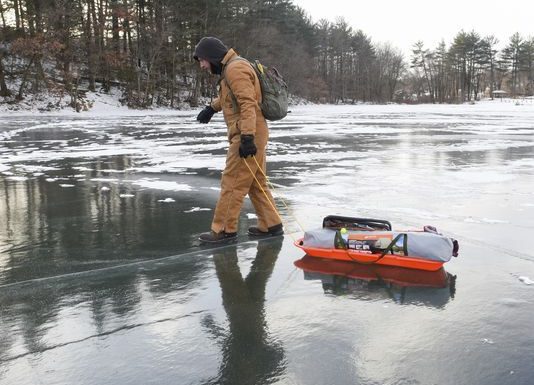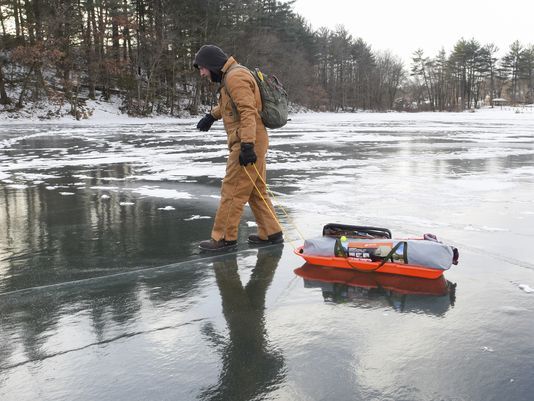
 Bitter cold that seized the East Coast will begin to ease this week as airlines try to get back on track after days of snarled traffic.
Bitter cold that seized the East Coast will begin to ease this week as airlines try to get back on track after days of snarled traffic.
By Monday and Tuesday, temperatures could reach into the 30s and 40s from Philadelphia to Boston after hovering in the 20s on Sunday, forecasters say.
“With the wind dying down it will probably feel significantly better, although many of these areas will still be below freezing,” said Patrick Burke, a National Weather Service meteorologist in College Park, Md.
But even as temperatures ease, icy precipitation forecast from Chicago to eastern North Carolina could make travel treacherous on Monday.
“Winter weather advisories are in effect for light freezing rain and sleet for these areas, and light to moderate snow farther to the north,” the National Weather Service said. “This will mainly be a nuisance type event.”
Delta Air Lines is already offering to change flights without a fee Monday and Tuesday for airports from Washington, D.C., to Boston.
“While heavy precipitation is not anticipated by the storm at this time, it just takes a small amount of ice to make roads and sidewalks a skating rink,” said Elliot Abrams, an AccuWeather chief meteorologist.
The slight warming arrives as the aftermath of a massive snowstorm continued to disrupt flights at New York’s John F. Kennedy International Airport on Sunday.
The storm that brought cold, high winds and snow across the East Coast — and as much as 18 inches of snow in some places Thursday — downed power lines, closed schools and disrupted travel plans. About 6,000 flights were canceled Thursday and Friday.
Charleston International Airport in South Carolina resumed flights Sunday after crews struggled Saturday with snow removal to reopen runways
Fights broke out Saturday at JFK airport as airlines tried to get passengers moving again after dozens of international flights were diverted for the storm. A water-main break at Terminal 4 delayed more flights Sunday.
The water-main break flooded part of the terminal and forced a partial evacuation, according to Pix11 News.
The Port Authority of New York and New Jersey, which runs the airport, said flight disruptions continued Sunday because of the surge of flights coupled with rescheduling international flights after a storm that disabled equipment
Tempers flared Saturday at the delays, and police responded to a scuffle at a Virgin Atlantic gate.
Traveler Jeremy Silver described the scuffle as a “near riot” to the Daily News of New York when travelers at gate B23 learned of their canceled XL Airways flight.
“It seems as if some punches were thrown as people jostled,” Silver said. “The crowd went nuts booing and shouting.”
Across New England, city officials struggled with water main breaks, frozen hydrants and burst pipes. Boston police urged residents to shovel around hydrants and remove snow from around car tailpipes and house exhaust vents.
Hartford, Conn., had a minus-20-degree wind chill and Burlington, Vt., had a minus-30-degree wind chill. The Mount Washington Observatory in New Hampshire was the second-coldest place on earth Saturday — tied with Armstrong, Ontario — with a minus-37 degree temperature and minus-93 degree wind chill
he National Weather Service said the observatory could expect a high near 7 degrees Sunday and a wind chill still as low as minus-40 degrees. Northwest winds could hit 60 mph with gusts to 80 mph.
Meteorologist Mike Carmon said people at the observatory were “layering up as a much as we can.”Even as temperatures begin to inch up, forecasters warned that light snow was expected Monday across Pennsylvania, New York and New England. Icy precipitation could spread from Chicago to eastern North Carolina.
While the cold will be milder than the bitter wind and snow from Thursday’s storm, forecasters said the precipitation on already frozen ground could make travel hazardous.
Light snow is expected around Interstate 80, with less than 2 inches in New England. The bulge of icy precipitation south and west of Pennsylvania could make the after-school and after-work commute slippery from Pittsburgh to Winston-Salem, N.C.
Pavement could get slippery from Washington, D.C., to Philadelphia from 2 p.m. to 8 p.m., and around New York City from 4 p.m. to 10 p.m., according to Dave Dombek, a senior meteorologist at AccuWeather.
“We expect a four- to eight-hour period of freezing or frozen precipitation,” Dombek said.
Meanwhile, a Pacific storm could drench California on Monday and Tuesday, threatening mudslides after a spate of wildfires in the fall, and could bring a foot of snow to the Sierra mountains.
Los Angeles could get an inch of rain, for the first measurable precipitation since Nov. 17 and the first major storm since last February, according to AccuWeather.
“Should that amount of rain materialize, it is enough to raise the risk of flash and urban flooding in Southern California from Monday night to Tuesday night,” said Ken Clark, a senior meteorologist at AccuWeather.
San Francisco could get 2 inches, according to the National Weather Service.
“Overall, mudslides and other associated hydrologic issues will be likely anywhere across the state where burn scars exist from the active fire season in late 2017,” the weather service warned.
courtesy= .usatoday.com
.

